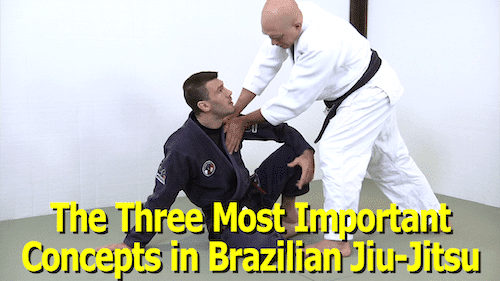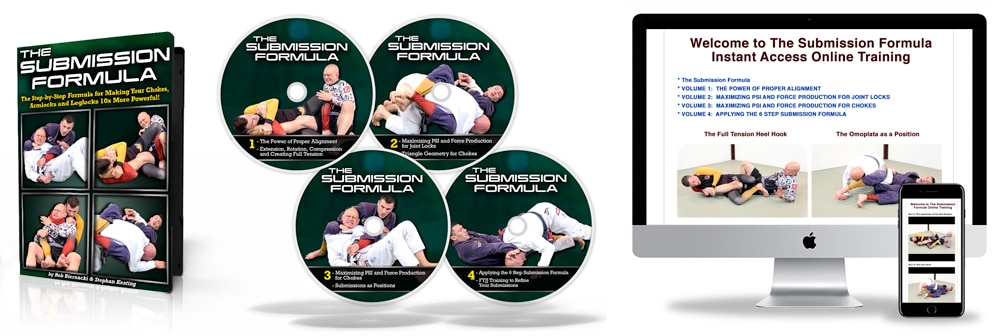Today we’ll cover the real ‘secret’ to using the triangle choke against higher belts from your guard – it’s all about the set up!
Tapping out higher belts is a different thing than tapping out beginners…
There are certain techniques that serve you well against white and blue belts. But when you climb the ranks and start sparring against higher caliber opponents some of those moves stop working.
The classic example of an entry that works best against lower ranks is the push-pull setup to the triangle choke from closed guard…
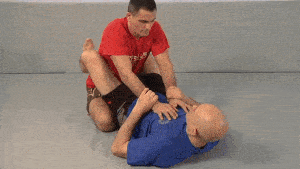
Push-Pull Triangle Choke Entry
It’s important to clarify that I’m NOT dissing the triangle choke: the triangle choke itself works a the highest level.
What I’m talking about here is the entry where you pull on one arm, push the other, and jump your hips into position.
This push-pull entry is a great technique to submit beginners and to develop some initial confidence in the submission, but it works primarily because it’s much easier to break the alignment of a less experienced grappler (in fact beginners will often break their own alignment and basically give you the submission on a silver platter).
But advanced grapplers habitually maintain better alignment, are harder to pull out of alignment, and don’t make the unforced errors that give you a clear shot to an easy submission. And thus eventually a once-effective triangle attack stops working.
So here’s the thing…
Before you submit a higher level opponent you first need to get them off balance, force their limbs out of position, or put them into an awkward situation where they can’t generate meaningful force.
This process is known as ‘breaking his alignment.’
First let’s quickly review this idea of alignment and the score…
Alignment in BJJ
Being in good alignment means that you’re a) ready to attack your opponent, b) defend his attacks, and c) stay safe on the mats.
Alignment has been precisely defined by my friend Rob Biernacki as consisting of 3 components: base, posture and structure. Here are some quick definitions of those terms…
Base: Base means having a platform from which you can apply and absorb force in a relevant direction.
On our feet this might mean being in a good stance so you can easily move forwards, backwards, left and right. On the ground it might mean being in a good position to strongly bridge into your opponent before performing a hip escape.
Posture: Posture refers to having your spine in strong position, from your neck all the way down to your lower back. If your spine is bent, twisted, or kinked then it is unlikely that you’ll be able to move effectively or powerfully.
The simplest example comes from weightlifting where it’s critical to have your spine lined up correctly to squat or deadlift heavy weights. But correct spinal position is important in all sports, and that includes grappling too!
Structure: Structure is defined as, “The most efficient way to use your limbs.” That means being able to use your arms and legs to grip, hook, create frames, and not having them dangle in space where they can easily be attacked.
Structure is more situational than the first two aspects of alignment because correct structure can vary depending on your position and in relation to your goals.
This has been a very abbreviated discussion of alignment. Check out the ‘Base, Posture and Structure, the 3 Most Important Concepts in BJJ‘ article on this site for a deeper discussion
What’s the Score?
As Rob Biernacki and I discussed in the ‘Unified Theory of BJJ’ section of The BJJ Formula in every situation in BJJ there’s something called ‘the score’.
The score is a way a keeping track of your alignment and your opponent’s alignment and is useful because it tells you what you can do next.
Basically in any situation both you and your opponent each get a score that ranges from 0 to 3, meaning that examples of scores could include 3-3, 3-1, 2-3, 0-3, etc.
So how do you calculate this score?
- If you’re in good base, posture and structure then your score is 3.
- But if one of these three components is compromised then your score is 2.
- If two of these components are compromised then your score is 1
- And if you’re completely unaligned then your score is zero.
The exact same goes for your opponent.
So if both of you are in great alignment then your score is 3-3. If you’re perfectly aligned but your opponent’s base OR his posture OR his alignment is compromised then the score would be 3-2. If he’s compromised two of the above – his posture AND his structure say – then the score would be 3-1 in your favour.
Let’s take a look at a couple of examples…
In the first picture even though I’m on the bottom I’m still in good alignment against Rob Biernacki. My feet are in contact with the ground so I can bridge into my opponent (good base). My spine isn’t compromised (good posture). And my arms are in effective defensive positions (good structure).
My score is a 3 and so is Rob’s, meaning that the total score is 3-3; the odds of him submitting me without doing further work are very low.
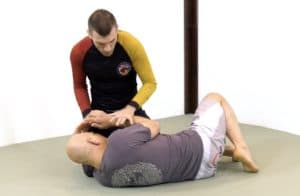
Good posture for the man on the bottom: score is 3-3
Now let’s consider a very different situation…
In the picture below Rob has turned my legs away and is preventing me from making effective contact with the ground so I have no base. My spine is twisted and my neck is kinked forward so my posture is compromised. And my arms and legs are out of position, so my structure is also destroyed.
In this situation my score is 0 and Rob’s score is 3, for a total score of 3-0 in his favour. If Rob was to pursue a submission here his odds of success would be very high!
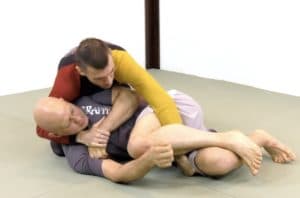
Bad posture for the man on the bottom: score is 3-0
The bigger the difference in the score, the better off the attacker is.
A difference in score of one point (3-2, for example) means that you can probably sweep or advance your position. But a difference in scores of 2 to 3 points means that you can probably submit the other guy.
Your goal in BJJ is to keep yourself at a score of 3 at all times, and continuously chip away at your opponent’s score.
Let’s take a look at how this alignment and score stuff works to hit more triangle chokes from the guard…
Setting up the Triangle Choke from the de la Riva Guard
The triangle choke is one of the most dominant submissions in BJJ, but you can’t just spam it repeatedly. You need to set your opponent up first, and that means breaking his alignment.
In the picture below Brandon ‘Wolverine’ Mullins is using de la Riva guard.
My feet are under me, my spine is straight, and although he he has a grip on my sleeve my arm isn’t dominated. The score is 3-2.5 in his favour; I lose a half point because he has my sleeve.
Despite the sleeve grip it’s not a terrible situation for me: I can still defend most attacks, gripfight to get back to parity, and work on putting him in a bad position.
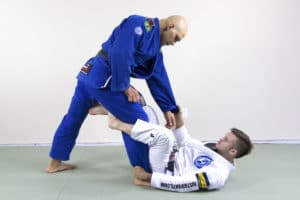
Now let’s take a look at a situation where my base, posture and structure are all compromised.
In the picture below my left arm is trapped between my legs so my structure is gone. I’m off balance forward and if I lift my right hand then I collapse onto my face so my base is gone Even my posture has been compromised, as I am bent forward by a strong downwards pull on the lapel.
My score is 1 at best, and maybe as low as 0.5. Brandon, by contrast, is in great alignment so his score is a 3.
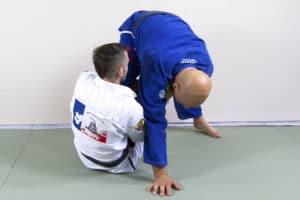
Now if the score is 3-1 or better it’s definitely time to attack with a submission!
If you know the right steps it’s very easy at this point to move on and apply a match-ending triangle choke.
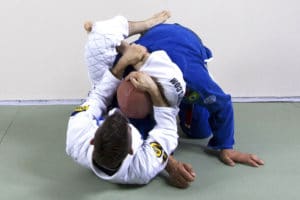
I know what you’re thinking: how on earth do we go from the first picture in which I’m in pretty good position to the second picture where I’m in a terrible position to the third picture where I’m about to tap?
Well, I’m glad you asked!
Let me break it down for you in both video format and photographic steps.
Triangle Choke from the de la Riva Guard, Video Format
Here from the Nonstop Jiu-Jitsu instructional project is no gi world champion Brandon ‘Wolverine’ Mullins breaking down the detailed steps that take you from the de la Riva guard to triangle choke by using the ball and chain sweep as a setup.
Triangle Choke from the de la Riva Guard, Step by Step Pictures
If you prefer to see the same de la Riva guard triangle choke set up as a pictorial tutorial here you go!
(These images are from pages 188, 189 and 190 of the Nonstop Jiu-Jitsu book by the way.)
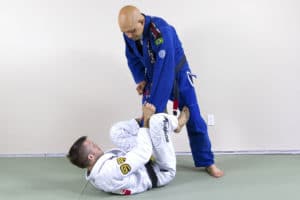
Brandon has me in the de la Riva guard
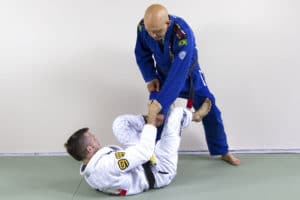
He pushes my left leg away to disrupt my base
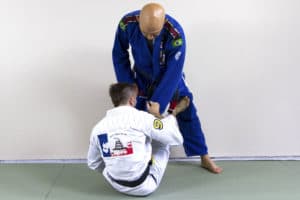
Brandon sits up, maintaining his grip on my left sleeve
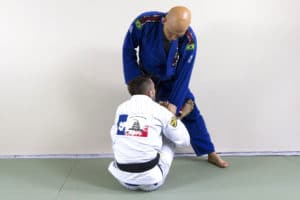
He feeds my arm between my legs and transfers the grip to his left hand
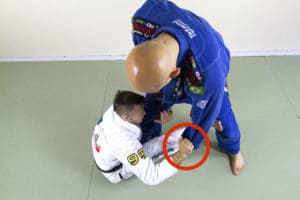
DETAIL: Brandon starts sitting up controlling my left sleeve with his right hand
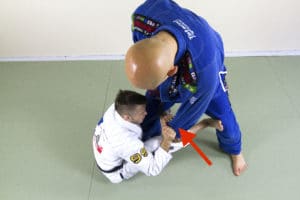
DETAIL: He passes my sleeve through my own legs to his waiting left hand
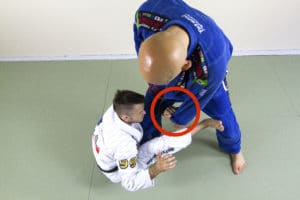
DETAIL: My arm is now trapped between my legs, completely disrupting my structure
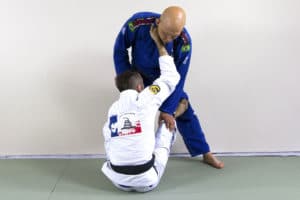
He grips my lapel with his right hand which is now free
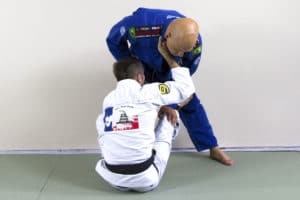
He pulls down to break my posture
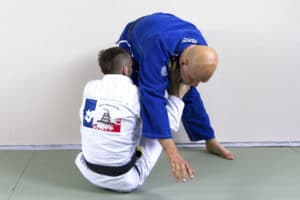
I lose my balance and reach forward with my free right hand

I base on the floor, completely out of alignment
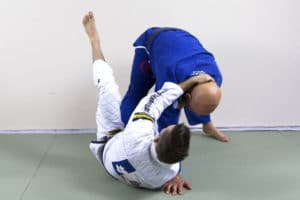
Brandon controls my head with his left hand and opens his legs
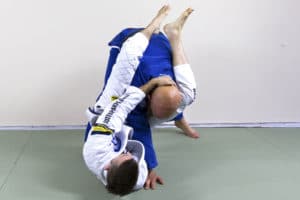
He shoots for the triangle position, trapping my head and my right arm between his legs
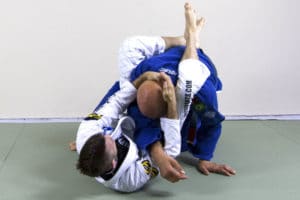
Brandon uses both hands to pull my head and break my posture further
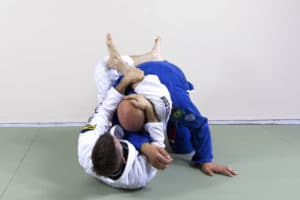
Maintaining the grip on the head with his right he pulls his shin across the back of my neck with his left
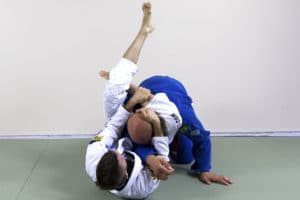
He shoots his left leg high and begins closing the triangle

Brandon finishes the triangle choke by pulling down on my head and on his own shin, squeezing in with his legs, and doing a slight crunch upwards
Another Example of Breaking Alignment Before the Triangle Choke
I want to give you another example of setting up the triangle choke with an alignment break.
Here’s a quick 2 minute video of one of my very favorite submissions from butterfly guard. The keys are establishing a 2-on-1 grip to disrupt his structure, and then kicking out one of his legs to totally destroy his base.
It feels like magic when you pull it off, so check it out!
Click here to get some killer details on actually finishing the triangle choke, even against a much bigger opponent.
The Offbalance-Sweep-Submit Formula
The take home message is that just spamming triangle chokes from guard almost never works against quality opponents.
Before you submit you HAVE to get them out of alignment first.
(By the way the same is true of armbars, collar chokes, omoplatas, Kimuras, and all other submissions from the guard too!)
The best way to get them out of alignment is to first offbalance them with kuzushi and then hit them with a legitimate sweep attempt.
There are actually two complementary goals: 1) either the sweep attempt works, in which case you come to the top, or 2) your opponent doesn’t get swept but the sweep further breaks his alignment giving you that magic moment to attack with the submission.
FIRST Off balance, THEN sweep, and THEN triangle choke them!
Good luck with your training,
Stephan Kesting
Related Instructionals
Nonstop Jiu-Jitsu Book with Brandon Mullins and Stephan Kesting
Nonstop Jiu-Jitsu is the giant new BJJ book by Brandon ‘Wolverine’ Mullins, a BJJ black belt world champion, and Stephan Kesting, a renowned BJJ black belt educator with 40 years in the martial arts.
This book is laid out in gorgeous full colour and multi-page spreads where you’ll learn plug and play gameplans for exactly how to control and submit your opponent on the ground. These techniques and combinations have been developed and tested over decades of competition so you know you can rely on them when the chips are down.
You’ll also get advanced details, training tips and conceptual breakdowns that will make your jiu-jitsu more powerful than ever before.
Click here for more info about Nonstop Jiu-Jitsu, the book.
BJJ Formula with Rob Biernacki and Stephan Kesting
The BJJ Formula with Rob Biernacki and Stephan Kesting is a four volume, eight hour masterclass taught by BJJ black belts Rob Biernacki and Stephan Kesting.
This is a totally revolutionary approach to BJJ that will allow you to hack Brazilian Jiu-Jitsu and become an effective grappler much faster.
In this set two experienced black belts take you through the most effective techniques in BJJ as well as the underlying concepts, breaking things down into bite-sized pieces making it easy to learn and retain the material
Click here for more info about The BJJ Formula
The Submission Formula with Rob Biernacki and Stephan Kesting
In The Submission Formula Rob Biernacki and Stephan Kesting will make your chokes, armlocks and leglocks MUCH more powerful than they are now. Making your submissions stronger is a matter of having your technical details correct, not spending more time weightlifting.
Using this step-by-step formula you’ll learn how destroy your opponent’s alignment, create full tension, maximise your force production, and refine your positioning to make it impossible for your opponent to escape or even resist your attacks.
Click here for more info about The Submission Formula
The post How to Set Up the Triangle Choke from Guard appeared first on Grapplearts.

